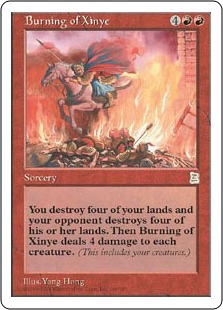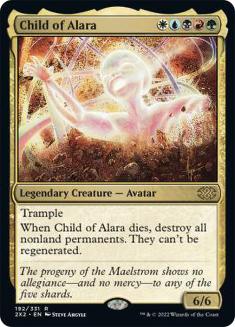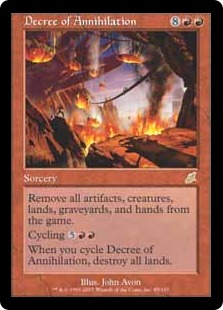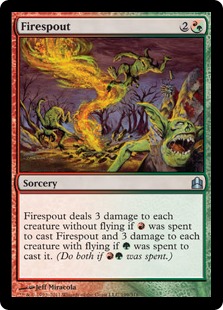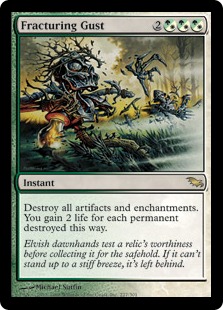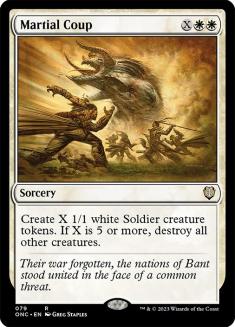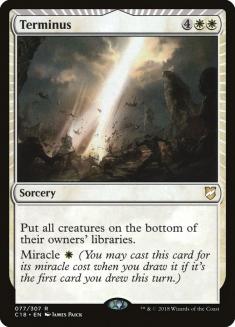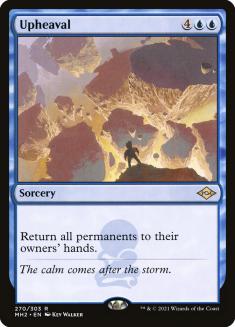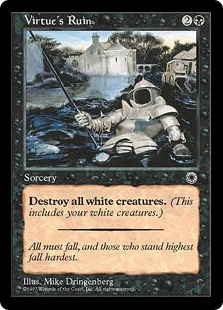Some weeks, I choose the topics. Other weeks, the topics choose me.
It was never in doubt that I was going to spend a large portion of this article discussing last week’s Comic-Con announcement, but I was blindsided by
everything that has happened since. On Monday, news broke about significant changes in the judge program. On Tuesday, Organized Play was hit with a seismic
overhaul. On Wednesday, we learned that the path to the Pro Tour was returning to MTGO and mysterious new foils started appearing in judges’ mailboxes. I
can’t remember the last week with so much to talk about.
Let’s tackle things one at a time then, starting with…
Khans of Tarkir
Here is everything that we know about Khans of Tarkir so far:
Khans of Tarkir is a wedge set, similar to Shards of Alara but with the opposing color trios.
This is something that players have been after for years: the completion of a slow burn cycle that started with Shards of Alara. If you weren’t around back
then, expect a lot of two-and-three color cards that are powerful in casual play but might not exactly be tournament powerhouses. A certain number of
mythics will need to be devoted to splashy three color things that won’t be playable in Standard unless the mana gets really good and/or aggro decks go
away entirely. Mana Confluence seems like a good buy regardless because people are going to try and play as many of the crazy new cards as they can. This
may also help boost the fortune of some of Theros’ gold cards-Kiora, say, or Ashiok-but don’t forget that the rotating block has more of a multicolor theme
than Khans block will.
It is likely that we will also see an uncommon land fixing cycle similar to the three-color CIPT lands from Shards. If so, they’ll be nice long term holds
in the $1-$2 range.
Khans of Tarkir was designed as a bottom-up set where each clan has a dragon attribute.
This means that the flavor of the set was designed around the wedges as opposed to building mechanics around, say, what a Greek God might look like in card
form. There’s not much we can say about the set financially based on this fact unfortunately. Innistrad was a top-down set filled with financial goodies;
Born of the Gods was a top-down set that wasn’t. Return to Ravnica was a bottom-up set with tons of great staples; Dragon’s Maze was a bottom-up set that
was a total bust. It goes both ways.
The rest of Khans block is not wedge-related.
This isn’t a big surprise, nor is it all that different from what happened last time-the second two blocks in Shards of Alara weren’t wedge-related either.
Conflux was based around five-color cards and the blending of the Shards and Alara Reborn was an all-gold set. This time around though, we might not see
many gold cards at all in the second and third set. They could be more like Theros or Born of the Gods with only a few cycles of multicolored spells.
If this is the case, it’s even more likely that the heavy tri-colored cards in Khans won’t define Standard because we won’t be as incentivized to play them
going forward. It also means that cards like Soldier of the Pantheon – a popular spec and short term gainer right now for obvious reasons – might not be as
impactful over the long term it would be otherwise. (I still like it as a short term riser.) It also means that there might be an October/November window
to buy in on solid mono-colored cards like Thassa, Master of Waves, and the mono-green monsters. Standard might be shaken up far more than normal by the
winter and spring sets, leading to a healthier and more exciting format.
Khans block has a time travel theme.
It seems likely that we’ll go back in time to before the Khans were a thing (meaning no wedges) and that we’ll see the dragons that everyone is going on
about. Could they possibly be Eldrazi titans in disguise? Eldrazi dragons, maybe, like how there are dinosaur Transformers now? That’s similar to what
happened in Zendikar block, but I wouldn’t be shocked if Wizards does something like that this time around, too.
Regardless, the last two sets in this block could be literally anything. They could even be a boat!
Each clan has a three-color leader.
And we even got to see one of them! Here he is:
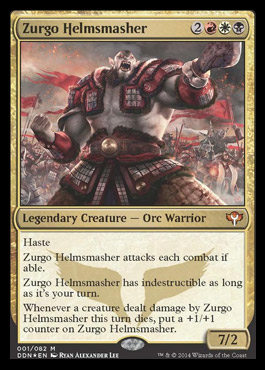
It’s impossible to say whether Zurgo will be good in Standard until we see more of the set. If he doesn’t get enough support and/or removal is prevalent
enough, he’s going to be too clunky. If the wedges are pushed enough, Zurgo makes for a nice finisher. I predict that we’ll see a bunch of situational
mythics like this, and only a few of them will make an impact. If you do like this card though, Mana Confluence is the clear buy as are the enemy pain
lands. You think Zurgo care about lose life? Zurgo smash!
The limited format will be large-small-large.
This is good news. What do Lorwyn/Shadowmoor block, Zendikar block, and Innistrad block all have in common besides being great? They all followed a
large-small-large structure. Granted, Avacyn Restored wasn’t the most fun set to draft, but large spring sets tend to provide a lot more creativity and
excitement than the normal block structure. Expect next summer’s bear market to be shorter and less pronounced.
The winter set will now release in January, with the spring set coming out in March.
This change is bigger than you might think. As a comparison, Born of the Gods came out on February 14th, and Journey into Nyx came out on May 2 nd. Even if the spring set is released on the last day of March, that still means that it’s coming out a full month earlier than it did this
year. And assuming that they’re not going to release the winter set two days after New Years’, there isn’t going to be all that much time before the spring
set spoiler season begins.
My colleague in the world of Magic finance, Travis Allen, believes that this hints at the possibility of a big summer set announcement. Perhaps Modern
Masters II will see a wider release than Modern Masters I? Or perhaps there will be another summer product before M16? WotC did say that Conspiracy was a
success, and that they’ll be doing similar sets in the future, but they wouldn’t have known that when they came up with whatever is being released this
summer. I doubt we’ll see another crazy multiplayer thing until summer 2016.
Regardless, the block structure, aggressive schedule, and hints that the winter and spring set will be very different from the fall set seem designed to
fight against the kind of block fatigue we’ve come to expect in the winter and spring. The era of two small “fall set lite” sets that don’t impact Standard
all that much may be over, which would be outstanding news and should lead to more fun and financial opportunities for everyone.
The draft order will go: 3x Khans (in the fall), then 1x Winter Set + 2x Khans (in the winter), and then 2x Spring Set + 1x Winter Set (in the spring).
This is a genius way of ensuring that enough cards from each set enter the marketplace. The fall set will be opened heavily enough by the time the winter
set rolls around, and the extra pack of that (plus the fact that it will be opened alongside the spring set) should ensure that people open a ton of it.
The lack of a third spring set pack hurts, especially for a large set, but the fact that it will be released over a month early should make up for the lost
pack. I still expect the spring set to be under-opened relative to a fall set, which should make for intriguing spec opportunities, but the impact will be
less pronounced thanks to the earlier release date.
Morph will be a returning mechanic.
Morph wasn’t all that popular last time around, and it doesn’t seem like there’s that much more design space to mine here, but it’s still nice to see an
old friend return. In limited, Morph creatures behave somewhat similarly to the common bestow cycle in Theros in that you’re guaranteed an early play that
you can turn into a late game threat. This may signal that the draft format will be deep in a similar way to Theros with more playables at common than in
most sets.
For constructed, there aren’t a lot of high profile reprints that could help. Birchlore Rangers could make Modern Elves more of a thing, which would cause
those staples to increase in price. ( Here is what a decklist might look like, minus the Rangers).
Imperial Hellkite could be a potential third-set reprint if the dragon theme we all expect comes to pass, but it’s a long shot at best. Exalted Angel would
likely be outclassed in today’s power creep world.
My favorite morph-related pickup is Ixidron. The card is already kind of a blue wrath in Commander, and it re-sets all of your morph creatures when it
comes into play. It’s only $1 right now, and could easily hit $5-$6 if enough people decide to start running it in their casual decks.
Morph isn’t the only returning mechanic.
At this point, the other returning mechanic(s) could be anything. I’ve heard people mention Delve as a possibility, which is intriguing. I’d like to see
Battle Cry make a comeback too. Cycling paired well with Morph the last time around. Rebound would be a lot of fun. It’s too early to speculate based on
any of this, of course, so unless we’re getting riggers and contraptions, I wouldn’t speculate on anything here.
Wizards will be “bringing back something old that we have been asking about for a long time.”
Remember this tease from Pro Tour: Journey into Nyx? It’s possible that Mark Rosewater was talking about Morph, of course, but I doubt it – the ability has
never been all that popular. I’m still holding out hope for the Onslaught fetchlands myself. If they’re happening, the reveal will be at the PAX party, so
make sure you’re monitoring the news out of Seattle closely over Labor Day Weekend.
There will be forty prerelease cards – eight for each clan.
Or, as my friend Duncan said, there will be one prerelease card and thirty-nine suboptimal choices. All joking aside, this is a huge change that should
help alleviate one of the major problems with the seeded box prerelease structure. Instead of being able to choose a color and guarantee yourself the best
possible promo, which leads to feel-bad moments at a casual event, you’re now going to have to pick a color and hope you get one of the two or three “good”
promos instead of the five or six “bad” ones.
This is also big news for foil and promo collectors, who will now have to somehow track down all forty promos in order to complete their set. That’s crazy
considering that we’re just a few years removed from the days of one promo per expansion. The price for these cards hinges on whether or not there’s
alternate art for all 40 promos – if so, there will probably be a few that will have a very large premium attached to them based visual style alone.
Before this change, pre-ordering regular copies of prerelease cards was almost always a bad idea. With a few exceptions from the mythic rare era, (Wurmcoil
Engine, Emrakul, etc.) the prerelease helped saturate the market and prevent the promos from being good spec targets. Now that the prerelease will have
forty promo cards, the fact that additional copies will be entering the market this way won’t matter all that much. I actually expect the promo versions of
cards that end up being Standard staples to hold a premium over the set version – not as large a premium as the set foil, of course, but somewhere in
between. Overall, this move will make attending a prerelease much more potentially lucrative. I expect all of these promos to be undervalued to begin with
as people underestimate their rarity, so if you want them, buy in early.
From the Vault: Annihilation
We’ve had five cards from From the Vault: Annihilation officially spoiled: Armageddon, Wrath of God, Rolling Earthquake, Living Death, and
Cataclysm. This tracks nicely with an early rumor that purported to have the entire list. At this point, I’m calling that rumor legitimate, especially
because the revealed art for Cataclysm matches up with the picture on the spoiler. If so, these will be the other ten cards in the set:
People seemed disappointed when this list was teased, likely due to the absence of Damnation, but it’s a pretty solid set regardless. This is the first
foil printing for many of these cards which makes the box a must-buy for serious cubers. Rolling Earthquake and Burning of Xinye are Cube staples, and I
recommend selling any P3K copies you may have immediately because the price will tank fast. Set foils of the rest of these cards will likely drop a bit
too. Fracturing Gust has been dropping for a while, but it will continue to tumble when the market gets flooded with these. Virtue’s Ruin and Smokestack
will be nice long term holds because no other foil copies of these cards exist.
Duel Decks: Anthology
This product will reprint the first four duel decks: Elves vs. Goblins, Jace vs. Chandra, Divine vs. Demonic, and Garruk vs. Liliana. It is unclear yet
what the MSRP of this product will be, nor do we know whether it will be a limited run or if it will go wide to the big box stores as well.
If you have sealed copies of the original duel decks, don’t fret – the reprints will have new borders and copyright dates, so your investment is still
safe. The people who were willing to pay hundreds of dollars for old duel decks (and yes, those people are real – the four duel decks being reprinted book
for a total of $550 right now!) are still going to want the first printings.
The singles from these sets, however, are likely to drop. My biggest sell calls are the alternate art Demonic Tutor ($30) and alternate art Counterspell
($10). Both should drop in value by at least half when Anthology hits the shelves.
Commander 2014
We’re getting mono-colored pre-cons this time around, and each one will be headlined with a planeswalker who is usable as your Commander. And because I’ve
seen some misinformation about this…no, you still can’t make Ajani Vengeant or Jace Beleren your Commander. These new ones have special text at the bottom
allowing them to break the rules of the format.
Only one of the new Commanders has been spoiled, but it’s a good one:
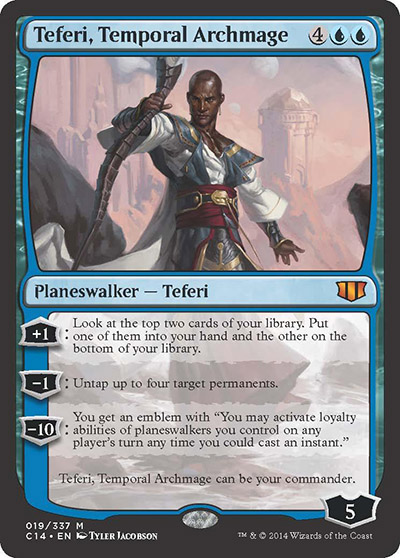
I love Teferi, but it’s pretty clear that he’s a Commander-only card. He’d be interesting if he were Standard legal, but you’re not going to pay six mana
for this in Vintage or Legacy. Expect these Commander sets to have their fair share of intriguing reprints alongside a few new valuable Eternal cards. WotC
said they’d try to stop planting Legacy stuff in casual products, but these sets were likely late in the R&D process before that call was made. Because
these boxes contain guaranteed planeswalkers, they’ll probably sell better than their 2013 counterparts, but you’ll still be able to find them for retail
(or less!) if you’re willing to be patient and wait a few months past release.
The Full Art Judge Foil Lands
We first learned about these lands a few months ago when Terese Nielsen teased the below photo on her Facebook wall. Last week, they began showing up in
the mailboxes of judges around the world accompanied by a vague letter detailing that a packet containing one of each land will be sent to every single
judge “as a means to resolve a current dispute.” From what I was able to find out, the dispute in question isn’t publicly known, but it isn’t related to
the Judge Exemplar Program or the loss of GP foils.
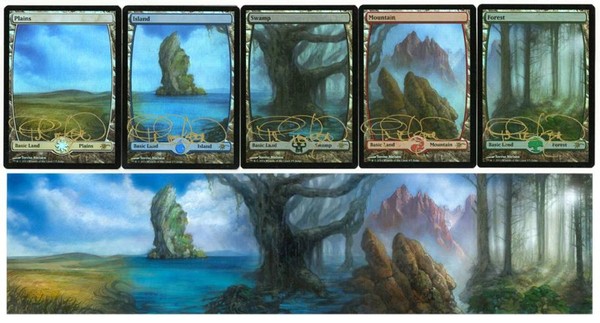
What we do know is that every active judge will be getting these, making them roughly as rare as the judge foil Dark Confidant. (To be fair, a few of those
showed up in conference packets, but I expect the same to happen here.) These lands are significantly less rare than the Force of Will but significantly
rarer than, say, Judge Foil Sword of Light and Shadow.
How expensive will these lands get? Let’s compare them to three other sets of incredibly valuable basics:
- Zendikar Foil Plains: $15 – $20
- Zendikar Foil Island: $20 – $35
- Zendikar Foil Swamp: $15 – $20
- Zendikar Foil Mountain: $15-$20
- Zendikar Foil Forest: $15-$20
The Zendikar foils were available in packs of a large fall set, so they are the cheapest of the bunch. Even still, they’re $15 on the low end. People
really like foil full art lands it seems.
- Unhinged Foil Plains: $60
- Unhinged Foil Island: $80
- Unhinged Foil Swamp: $60
- Unhinged Foil Mountain: $40
- Unhinged Foil Forest: $60
These foils are quite a bit older and rarer because much less Unhinged was opened than Zendikar. In addition, more of the surface area of these is
dedicated to the art, making them slightly more unique choices for deck building. The judge foils, by contrast, have the same frame as the full art
Zendikar lands.
- Guru Plains: $150
- Guru Island: $300
- Guru Foil Swamp: $180
- Guru Foil Mountain: $150
- Guru Foil Forest: $180
These lands are the rarest basic lands of them all. In order to get them, you had to jump through all kinds of hoops in an era when Magic collecting was
much less mainstream. The judge lands that came out last week are quite a bit less rare then these, but it is worth noting that both lands were drawn by
Therese Nielsen, an artist with a rabid fan base.
Card for card, these new judge lands are rarer than the Unhinged foil lands. They also have a Therese Nielsen premium attached to them, which makes sense,
because they truly are beautiful. During the middle of last week, judges were asking $25 each for non-islands and $40 for Islands and a set closed on eBay
for $130. That didn’t last long. The price has steadily increased since then, and many people are trying to get multiple copies of each for their Vintage or
Legacy decks. I had expected them to stabilize at $40 each, $70 for the islands before slowly creeping up into the $80-$120 range in a year or so. Nope –
sets are already closing over $300 on eBay which puts them in the $60-$70 each bracket already. I expect them to dip a little as the excitement dies down,
but long term, they have a shot at coming close to guru prices. I can’t recommend picking them up in the $300-$350 range, but if you can pick up a set at a
discount from a local judge, do it. They are solid long term holds.
The Judge Exemplar Program
Big changes are coming to the judge community. Starting in 2015, Wizards of the Coast will no longer be awarding foils to judges for working the Grand Prix
circuit. Instead, they will be awarded by higher level judges through the Judge Exemplar Program.
Have you ever wanted to become a judge after looking at beautiful foils like the Therese Nielsen lands? Me too. I’m friends with a lot of judges though,
and they’ve all told me the same thing: do not become a judge just for the foils. The promo cards are a nice source of compensation and recognition, but if
it’s foils you’re after, it’s far more lucrative to get a second job doing something else and using your paycheck to buy cards on the secondary market.
When you add it all up, judging Magic events does not pay a very high hourly wage.
Will things get worse for judges with the Exemplar program? The jury is still out at the moment. On the positive site,
it certainly looks like just as many foils will be distributed throughout the judge community in 2015 as there have been in 2014
.This means that you shouldn’t see any appreciable change in the price of judge foils – if less get distributed, the price for each one will be
comparatively higher. I wouldn’t worry about that for now, though. I’m going to start the new year treating judge foils the same way I do today, buying in
about 3-4 months into the distribution cycle for each card.
What will change for judges? Instead of having their compensation tied to working large events, judges who help the community in other ways – blogging,
mentoring, etc. – will be rewarded as well. This will be great for people who have good relationships in the community and love to help out in unique and
creative ways. It might be brutal for lower level judges who may work three or four straight 14-hour days at 4,500 person GP for zero compensation though.
For some, this last point will be a deal breaker, but overall I am hopeful that it will strengthen the judge community. Most of them truly love the work,
and hopefully they’ll be rewarded for it in kind.
The New Path to the Pro Tour
The biggest change in Magic this week happened in Organized Play.
Financially, these changes are a huge deal. People are going to radically change how they approach building decks and playing competitive Magic.
First off, the bad news: qualifying for the Pro Tour will be harder than ever next year. These changes are bad for the grinders who travel from PTQ to PTQ
hoping for that one glorious day where they run good for ten straight rounds or open that can’t-lose sealed pool. In the new system, you can lose an entire
season to a bad open or a few mulligans at Regionals. This is fine in theory, because it rewards skill over luck, but it’ll feel awful when it happens to
you.
The new system will also hurt people who live in really remote areas or in big, dense cities with lots of Magic players but comparatively few stores, like
New York City. Rural players may only have one or two shots at a prelim, only to have to travel thousands of miles for their regional qualifier. Players in
cities like New York may end up packing a local store with five hundred or more players during a prelim, completely overwhelming them and causing ownership
to turn people away. The new system is not perfect, and it will not work well in some places. In many ways, it has the same problem that getting rid of the
regional prereleases did – things will be fine if you’ve got a couple of great local stores but brutal if you don’t.
The good news for us is that this system is WAY more appealing to casually competitive players. It’s hard to believe if you’re a
grinder yourself, but making that first step from the local FNM scene to a 100-person PTQ down at the Elks Club is a big one. Players will go years without
making that leap, especially if qualifying for the Pro Tour is more of a pipe dream than a goal. But playing in a prelim in the comfort of your local
store? That’s a jump that anyone can make. And if you do well and win the event, well, why not try your luck at Regionals? This new system is going to get
many more people involved and excited about competitive Magic which should help drive grass roots interest in both Modern and Standard.
The end of PTQs is going to be hard on small regional dealers, however. You know the guy who set up a booth at your PTQ? His best avenue for buying singles
has just been axed, along with his best way to sell cards at retail prices. Since prelims will be run out of local stores, outside dealers aren’t exactly
going to be welcomed with open arms. At this point, these guys are stuck competing with the big dogs at GPs and online. Some of them will likely close and
move on to other pursuits. As a trade grinder, this may make it harder for you to buy and sell your cards to local dealers, forcing you to do more of your
business online.
Grand Prix are now much more important to the Magic landscape. There are more of them, the parameters for them have been better defined, and they offer
more chances to qualify for the Pro Tour. This is great – going to a Grand Prix is awesome, and they will now draw even more of the best and most dedicated
players from around the region. Expect massive GPs to be the new normal from now on though, and plan accordingly.
MTGO has once again become a place where you can qualify for the Pro Tour which is fine as long as the program works. I think that the return of these
events is essential at some point, but I worry that it happened too soon. V4 is still a buggy and unstable client, and V3 had a bunch of high profile
missteps that caused these events to be suspended in the first place. If the same thing happens again, it will make the new client rollout feel like even
more of a boondoggle. If WotC is forced to roll back these events yet again, I’m not sure they’ll ever come back.
Back in the world of paper Magic, it’s important to note that PTQ seasons are now a thing of the past. You can now win a Standard prelim and a sealed deck
regionals in order to qualify for a Modern Pro Tour. As I said in my article two weeks ago, the concept of competitive Magic seasons was
just about dead anyway, but this puts the final nail in the coffin.
The good news is that this means that stores can better support their favorite formats, allowing more local players to get in on the action without having
to play something weird that they’re not used to. This may lead to some odd regional pricing, which should help out some value traders. If Modern goes
unsupported in your area, for example, you’ll probably be able to pick up Modern staples at a discount, which you can then turn around and sell online,
using some of the money to pick up Standard staples. Rinse, lather, repeat.
This change also means that grinders are going to have to stay current in both Standard and Modern at the same time. Most of them are already doing this
because of 5k events and Star City Opens, but if you’re going to travel around to different prelims in search of a regional qualification envelope, you’ll
need to be current in all formats. This means that there will be less downtime in the major formats, raising overall demand for competitive staples.
Indeed, this change – like much of the news we’ve gotten about Khans block – seems aimed at destroying seasonal sales lulls and making sure that we’re all
excited about Magic all year long.
This Week’s Trends
– Forget about the future, Soldier of the Pantheon is good right now, and it has started showing up in multiple Top 8 lists. Standard is still mostly
dominated by the same old cards though, with Jund and G/R Monsters, Mono-Blue Devotion, and Mono-Black Devotion still reigning supreme. Both core set
Ajanis have showed up in Top 8 lists recently, while Nissa has started falling back to Earth due to a lack of play. I still like her as a Standard staple
for the fall, but she can’t maintain that price tag unless she starts seeing more play. I’m selling right now and looking to buy back in later.
– What do Scavenging Ooze and Young Pyromancer have in common? They’re both Modern staples that are seeing a pre-rotation drop. I like them as trade
targets this weekend. I’m also after more copies of Master of the Pearl trident now that Merfolk is starting to make legitimate inroads in Modern.
– Someone bought out Flames of the Blood Hand and Sliver Overlord. I’m not sure why Flames was targeted – it doesn’t see much play these days except in
random burn and Goblin decks – but the Sliver Overlord spike should stick. It’s $15 on Star City right now, and it could hit $20 or $25.

